Kāpili Summer 2016 Newsletter
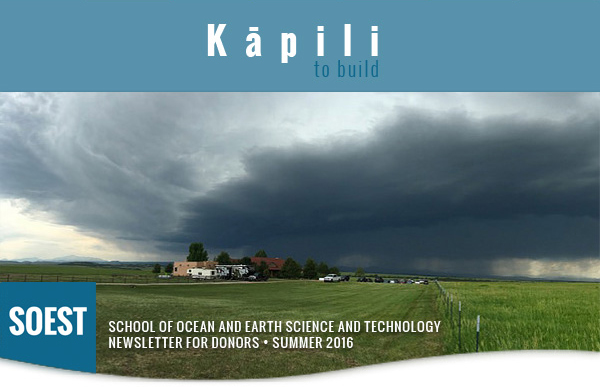
Contents
- Letter from the Dean
- Letter from the Fundraiser
- Uniting Research and Community: Mark and Jo Ann Schindler
- A Model Partnership: Jonathan Merage Foundation
- 50 Years of Excellence: Ocean and Resources Engineering 50th Anniversary
- Getting Their Hands Dirty: G&G Undergraduate Field Trip to the Mojave Desert
- 2016 Spring Graduation
Letter from
the Dean
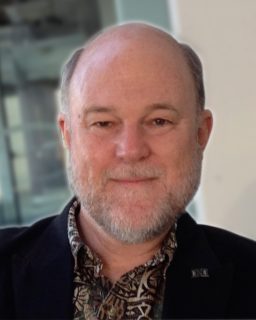
Dr. Brian Taylor
The School of Ocean and Earth Science and Technology seeks to enhance the quality of life in our state and nation by creating new knowledge, providing world-class undergraduate and graduate education, contributing to a high-tech economy, and promoting the conservation and sustainable use of the environment. We have consistently delivered on that goal, while becoming the largest research unit within the University of Hawai‘i and one of the top geosciences schools in the world.
We have much to be proud of, and we know very well that we could not do this on our own. SOEST’s accomplishments would not be possible without you, our donor ‘ohana. Your gifts have enabled us to provide scholarships and fellowships to high-achieving students, grow enrollment, support new and exciting research ventures, enhance the quality of our learning environments, bring world-renown scientists and guest lecturers to campus, provide outstanding field work opportunities for our undergraduate students, and engage the public on issues concerning the wellbeing of Hawai‘i.
It is thus with deep gratitude that I introduce the inaugural SOEST donor newsletter. We are starting this newsletter as a way to share with you the successes you have made possible, the outstanding work of our faculty and students, and our goals and vision for the future.
Thank you all for your wonderful kōkua. We look forward to sharing with you through this new means, and welcome your feedback.
Sincerely and with aloha,
Brian Taylor
Dean of SOEST
[Top of page]
Letter from
the Fundraiser
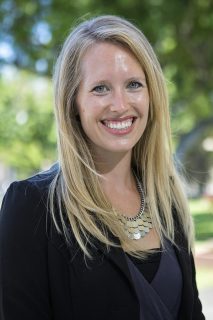
Jana Light
It is with pleasure that I welcome you to the first School of Ocean and Earth Science and Technology donor newsletter.
Looking back at the past academic year, my first raising support for SOEST, I am amazed by the generosity of the SOEST family of donors. I have met faculty who donate over $300 monthly to provide much-needed support to their department. I have seen donors support the media and communication efforts of our marine biology research. I have met donors who decided to create new scholarships, donors who have included SOEST in their estate plans, donors who have supported new research ventures in hurricane modeling, and many others. It has been a pleasure to discover the generosity of SOEST’s donors, friends, and alumni, and to work with you to help SOEST achieve its aim to change the way people live and thrive on Earth.
We have named our newsletter “Kāpili,” which means “build” in Hawaiian. The name is an homage to how you have helped SOEST become the top research unit at University of Hawai‘i and one of the top 20 geo sciences schools in the world, as well as an encapsulation of our ongoing goal for SOEST’s future — a goal we hope you share with us.
Mahalo for all you do to support SOEST. I hope you enjoy reading about our successes this past year, and I look forward to finding new and exciting ways to partner together for the benefit of SOEST, the state of Hawai‘i, and the planet.
Best,
Jana Light
Associate Director of Development
[Top of page]
Uniting Research and Community
Mark and Jo Ann Schindler
Mark and Jo Ann Schindler believe strongly in public access to information, even dedicating their careers to the cause: Mark worked for 32 years as a professor of physics and astronomy at Honolulu Community College, and Jo Ann for 28 years in the Hawaii State Public Library System (three of those as Hawai‘i State Librarian).
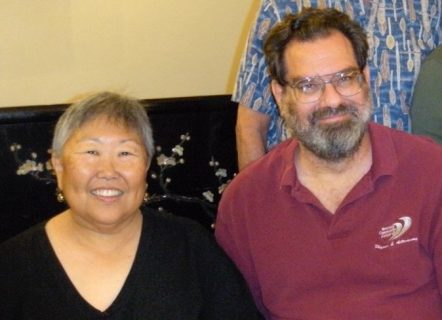
Mark and Jo Ann Schindler
They are also keenly aware of the limitations of federal and state funding.
While federal and state funding provides generous support to research institutions, grants generally leave little for community outreach and public engagement. As a result, the Hawai‘i community often remains unaware of some of the most groundbreaking research coming out of institutions like the University of Hawai‘i.
Mark and Jo Ann first became excited about taking an active role in improving public awareness of University of Hawai‘i research after attending Dr. Karen Meech’s TOPS Program in 1995, a summer astronomy workshop for both students and teachers. They became further engaged after hearing a public lecture by Dr. Chip Fletcher on climate change and its impacts on the Hawaiian Islands.
Inspired by Dr. Fletcher’s commitment to bringing his findings to the public, the Schindlers dedicated a portion of their estate to supporting the community outreach efforts of both SOEST and the Institute for Astronomy. The SOEST portion of their gift will support public outreach regarding issues of climate change and regional impact.
“People need to know what Chip Fletcher and other SOEST researchers are discovering about climate change,” says Jo Ann. “We want our gift to ‘fill in the gaps’ left by other funding agencies, to enable researchers to take their research out into the community and to show how research and the community can together improve the wellbeing of the Hawaiian Islands and the people living here.”
Both retired, Mark and Jo Ann live on O‘ahu and spend their time reading, watching television, and talking themselves into exercising daily (walking for Mark; exercise classes and lap swimming for Jo Ann). Mark is a loyal UH baseball supporter. Jo Ann dabbles in family history research, attends the annual UH Mini-Medical School, and is trapped in the time sink known as Pinterest. Both love attending academic lectures and recently had the opportunity to visit the marine research institute on Coconut Island.
[Top of page]
50 Years of Excellence
Ocean and Resources Engineering 50th Anniversary
In the early 1960s, Dr. Charles Bretschneider looked at the vast resources of the Hawaiian Islands and decided the University of Hawai‘i needed to provide a degree that trained students how to harness, manage, and sustainably use the expansive resource of the ocean. In 1966 he created the Ocean and Resources Engineering (ORE) graduate program, one of the first of its kind in the United States.
In the 50 years since, ORE has produced almost 250 M.S. and 70 Ph.D. graduates working in all parts of the globe and has made an indelible impact on the development of the Hawaiian Islands and its neighbors across the Pacific. ORE has produced some of the most impactful local businessmen in Hawai‘i, with graduates going on to start engineering firms such as Makai Ocean Engineering, Oceanit, and Sea Engineering, Inc.
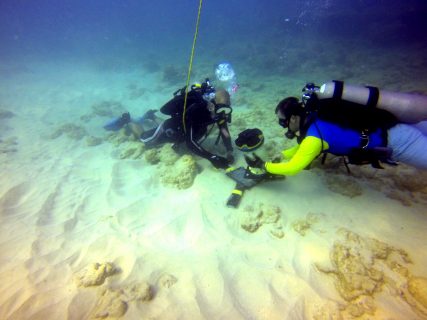
Divers deploy a bottom-mounted acoustic Doppler current profiler (ADCP), which uses sound to measure water velocity (current) with depth. Photo taken by ORE PhD student Conghao Xu during an ORE601 Ocean Engineering Laboratory field trip, led by Dr. Zhenhua Huang and Dr. Geno Pawlak with lead diver David Slater.
“ORE graduate a large proportion of practicing ocean engineers in Hawai‘i,” said Dr. Eva-Marie Nosal, Chair of the Ocean and Resources Engineering Department. “The program is an integral part of the local and Pacific basin-wide marine industry.”
In 1988, when the School of Ocean and Earth Science and Technology was formed, ORE moved from the College of Engineering to become one of the four departments in SOEST.
“The Department of Ocean and Resources Engineering is an important part of SOEST’s efforts to advance a sustainable economic and environmental future for Hawai‘i,” said Dr. Brian Taylor, Dean of SOEST.
ORE is celebrating its 50 years of excellence with an anniversary event for faculty, staff, alumni, and donors at the Waikīkī Aquarium on November 12, 2016. Please mark your calendars and visit the website below to learn more.
For information on the ORE 50th anniversary event, please visit sites.google.com/a/hawaii.edu/ore50/home
To learn more about the event and to sign up to make sure you receive an invitation, please email Jana Light at jana.light@uhfoundation.org
ORE is looking forward to its next 50 years of excellence, and would love your support! Please consider donating to the ORE Enrichment Fund at giving.uhfoundation.org/funds/12373104
[Top of page]
A Model Partnership
Jonathan Merage Foundation
This spring, the Jonathan Merage Foundation embarked on a long-term partnership with SOEST to explore how long-range lightning data can potentially improve storm forecasting.
“Through the ingest of lightning and storm balloon data, this project aims to increase our ability to map water vapor and heat associated with condensation of water in hurricane storm clouds in the core of the storm,” said Dr. Steven Businger, chair of the Atmospheric Sciences Department at UHM and project lead. “In the process, details of the initial storm circulation in the hurricane model will be improved.”
In future years, the way the lightning data are ingested into the hurricane model will be refined, to provide a more sophisticated and balanced approach that improves the way in which individual storm clouds evolve in the model. A number of poorly forecast recent hurricanes will be targeted as case studies to spur improvement in hurricane simulation and prediction.

Researcher Dr. Steve Businger and Jonathan Merage, founder of the Jonathan Merage Foundation, at the Jonathan Merage Research Ranch in Colorado after the storm balloon release.
Businger has been a pioneer in storm balloon development and suggests that floating storm balloons at low levels into a hurricane will provide crucial data on the energy exchange between hurricanes and the ocean surface beneath. The goal is to construct affordable storm balloons that possess the needed buoyancy control to allow them to remain near the ocean surface as they move towards the eye of the hurricane. They also contain GPS for position information and Iridium satellite communication to send data back on the energy exchange that governs hurricane intensity.
“Hurricanes are the most destructive storms on Earth and our ability to accurately forecast changes in their strength before landfall has not improved significantly in 20 years,” said Businger.
The project began the last week of June in Colorado with the launch of the first storm balloon. “It was a picture perfect first release,” said Businger.
For more photos of the storm balloon, flight path, and release site, please visit the UH Storm Balloon flickr page at www.flickr.com/photos/uhawaii/sets/72157669316265320/
For more information about Dr. Businger’s severe storm work, please visit his website at www.soest.hawaii.edu/met/Faculty/businger/
[Top of page]
Getting Their Hands Dirty
Geology & Geophysics Undergraduate Field Trip to the Mojave Desert

Geology & Geophysics Department faculty and students at the 2016 field trip site in the Mojave Desert.
Every Spring Break, all Geology & Geophysics (G&G) seniors leave the island and head to the Mojave Desert to embark on the annual G&G Field Trip. For Mainland students, it’s a chance to use their education to explore something close to home. For Hawai‘i students, it’s often their first opportunity to explore the geology of the world on the edge of the Pacific. For all students, it’s their opportunity to do the work of geologists, an experience they cannot get in the classroom.
“Geologists need to go out into the field to collect data so they have something to analyze in the lab,” said Lhiberty Pagaduan, 2016 Geology graduate. “The trip was a good eye-opener for all of us and got our feet wet in real geology work.”
Recognizing the financial hardship the trip may potentially place on students, the Geology & Geophysics department works hard to find and provide as much support as possible to the students, for whom the trip is required.
Thanks to generous donations by G&G alumnus Michael W. Jackson, two students’ costs were fully covered for the 2016 trip.
G&G remains committed to finding ways to help students get off O‘ahu and into the desert to gain new real-world geology experience. It is a career-defining moment for many students, and a capstone to a challenging four years earning their B.S. or B.A. in Geology & Geophysics..
“The trip is incredible,” said Diamond Techera, 2016 G&G graduate. “It’s a different way to look at what you’re around, and gives you new insight into the place you come from.
If you are interested in supporting student field trip engagement, please consider donating at giving.uhfoundation.org/funds/12428804
[Top of page]
2016 Spring Graduation
Congratulations to the SOEST undergraduate Class of 2016! A quick snapshot of our outstanding seniors:

SOEST undergraduate students celebrate earning their degree on May 14, 2016.
21 students walked the line in May and 10 more will graduate this summer
- 17 students graduated with a B.S. or B.A. degree in Geology & Geophysics
- 10 students graduated with a B.S. in Global Environmental Sciences
- 4 students graduated with a B.S. in Atmospheric Sciences
- 7 students are starting graduate school with SOEST in the fall
- 20% of the graduating class is from Hawai‘i
- 3 students are Native Hawaiian
A special thank you to our scholarship donors for supporting our students, including these graduating seniors. Many students could not attend college, much less participate in the field work so central to the SOEST curriculum, without donor support.
If you are interested in supporting SOEST undergraduate students, please consider donating to our undergraduate student scholarship fund at giving.uhfoundation.org/funds/12679204.
[Top of page]
For more information about how SOEST is using donor support to solidify its place as a world-class, top-tier geosciences school, or to make a donation, please contact Jana Light (jana.light@uhfoundation.org | (808) 956-9172).




